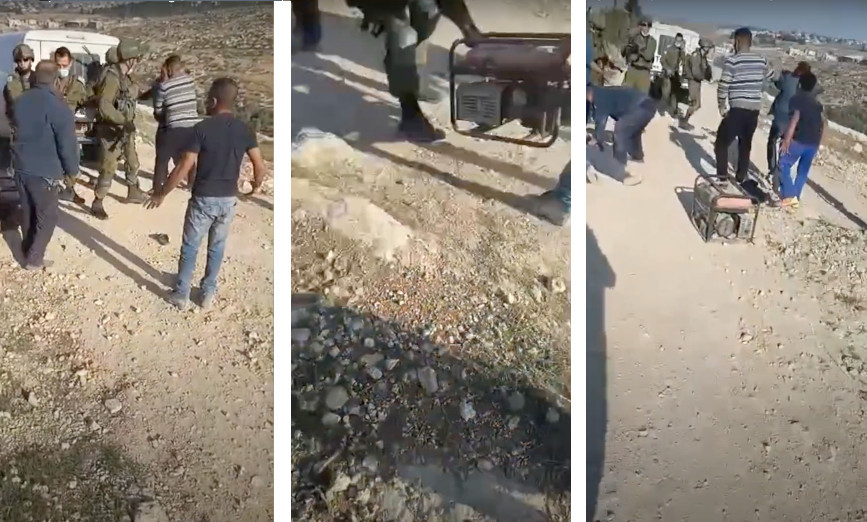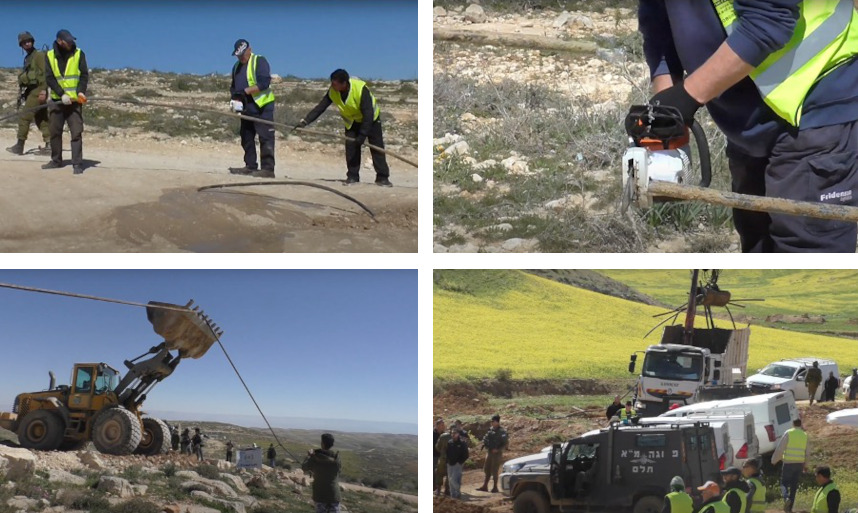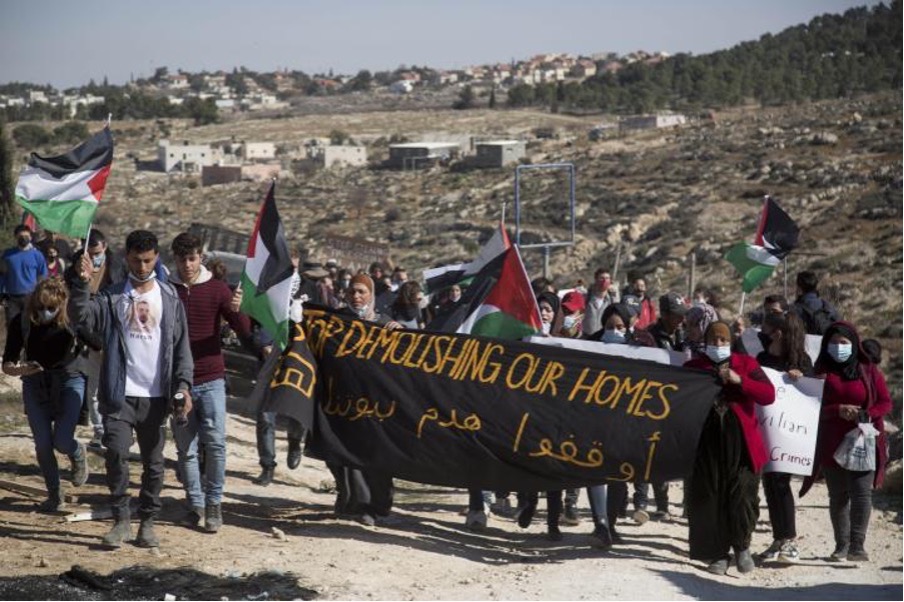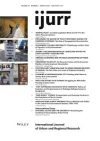On the first day of 2021, an Israeli army patrol with officers from the Civil Administration raided the Palestinian hamlet of Khirbet a-Rakeez and attempted to seize an electricity generator. Home to nine families, a-Rakeez is part of Masafer Yatta, a community of two thousand herders and farmers living under constant threat of displacement in the South Hebron hills. When residents rushed to stop the army from confiscating the only generator in the village, a scuffle ensued and Harun Abu ‘Aram, who turned twenty-four that day, was shot by a soldier at point-blank range leaving him paralyzed for life. As in similar instances of settler violence, the soldier was not indicted nor did he go on trial. Harun was using the generator to rebuild a friend’s barn that had been demolished by the Israeli authorities. His own family home was razed two months earlier. The generator also served to power electrical devices of various families in the hamlet, it was an essential community infrastructure.

Residents from Khirbet a-Rakeez impede the Israeli army confiscation of an electricity generator moments before Harun Abu’Aram is shot. January 1, 2021. Film screenshots used with permission © B’tselem
In Masafer Yatta, as in other rural communities in frontier regions like the Jordan Valley and the Naqab, the Israeli state prevents Palestinians from developing or connecting to existing energy, sanitation and transport networks, all while providing these very infrastructures to Jewish settlements as precondition for their existence. From the lands of a-Rakeez one can easily spot the electricity poles that connect the infamous hilltop outposts of Havat Ma’on and Abigail to the Israeli state-run national grid. It is from these and nearby settlements that settler mobs, protected by the army and border police, regularly descend to a-Rakeez and other hamlets in the area to attack residents, burn crops, chop trees, kill sheep and vandalize solar panels and water tanks. What the army does not demolish and confiscate, settlers scorch and wreak havoc.
I begin with this gruesome episode to illustrate the lengths at which the Israeli state goes to police and hamper indigenous frontier infrastructures. Like the demolition of homes, clinics and schools, settler attacks on electricity, water and roads are not an exceptional occurrence. Local and international civil and human rights organizations as well as residents, activists and journalists have for decades documented this form of infrastructural violence through exhaustive reports and, more recently, graphic films circulated via social media. There is an eerie, infuriating quality to this visual repository of ruination that records the routine of military convoys debarking in secluded communities to suppress resistance and protect subcontracted workers and bulldozers as they methodically cut electricity wires and wooden pylons, unearth and damage water pipes, demolish solar panels and rainwater harvesting tanks, and rip roads apart. Justified by the Israeli state on legal grounds, these overt and contested acts of violence betray the enduring predicament of Palestinian life in the frontier.

Israeli personnel from the Civil Administration, Army and Border Police unearth, cut and confiscate a five kilometer stretch of water pipe which served twelve communities (1000 people) in the area of Masafer Yatta. February 13, 2019. Film screenshots used with permission © B’tselem
In this essay, I think with Khirbet a-Rakeez and other frontier communities in Palestine as places that convey an insurgent geography of social reproduction in the margins. Their struggles for infrastructure are distinct from accounts where the denial and failed provision of essential services are either the result of state disinvestment due to neoliberalism, urban warfare strategies confined to war time, or a lack of funding and political will to extend national development across peripheral regions. Instead, what can be learned from this context is a more insidious history of the way indigenous infrastructures are constitutive of the logics of settler colonialism and racial capitalism as well as a vital terrain for land-based practices of anti-colonial resistance.
Matters of Reproduction
Settler colonial capitalism is fundamentally haunted by the question of indigenous social reproduction. That is, the practices, spaces and ecologies that support the biological and social reproduction of colonized bodies, households, communities and societies on a daily and intergenerational basis. This anxiety for the ‘messy, fleshy, stuff’ that sustains indigenous life and work fundamentally stems from the imperatives of settler statecraft. For these formations are structurally defined by a voracious determination for indigenous land theft, political conquest, economic exploitation and population removal to make space for an exclusive settler polity. Put differently, the material presence of indigenous communities stands in the way and poses a threat to settler aspirations for territorialization, accumulation and sovereignty. In this winner-takes-all model, the expansion and normalization of settler colonialism can only take place at the expense of devaluing and depleting indigenous worlds. This parasitic relation not only attaches revolutionary character to indigenous social reproduction, it necessarily places social reproduction as an essential yet underrecognized terrain of dispossession in existential struggles for life and land.
The intimate, private and domestic sphere of indigenous social reproduction has been a critical site of intervention for the racialized, sexualized and gendered violence of the settler colonial state – from the forced sterilization of women’s bodies and the separation of children from their families to the stratified regulation of fertility, marriages and family life. A more expansive understanding of social reproduction however must also contend with the built environment that enables the conditions for indigenous reproduction, in ways that both include and exceed the body and the domestic sphere. Basic infrastructures such as energy, sanitation and transportation are in this sense critical in-so-far as they provide the ability to reproduce ways of being in place and to sustain material livelihoods. Connecting the intimate scale of the body to the global, large and small infrastructures make possible biological reproduction, the reproduction of the labor force as well as social relations. The availability or lack of these material supports conditions thus the tight inter-linkages between productive and reproductive activities. Wires, pipes and ribbons of concrete are not just purely technical matters but structural and intimate necessities of the body politic; without them the possibilities of living a productive and dignified life become compromised. In this sense, the social in social reproduction is decisively a socio-material relation.
In Palestine, this relation and the indigenous architectures of social reproduction and care it sustains over time and space has been historically a matter of concern for Zionism’s double logic of primitive accumulation and elimination. Take, for instances, the settler extraction of imperial concessions to monopolize water and electricity development during British imperial rule, the dismantlement of energy production in territories occupied after the 1967 settler war, and the gradual appropriation and segregation of ancient trails and road systems that tie Palestinian communities on the mountain range to the rest of the country in the wake of the Oslo accords. These acts of infrastructural theft, undoing and replacement do not just tell a story in the abstract about an impervious drive to govern the urban environment. Rather, they signal a more fundamental, coercive and radical form of dispossession premised on seizing the infrastructures of social reproduction in an attempt to dissolve the indigenous bond between land and life. Infrastructures are after all about the ‘in-between’ territory and population that enables communities to biologically and socially reproduce but also to be held in place, to exert a physical presence that concretizes and makes possible forms of nationhood, knowledge, development and self-determination. In other words, the availability of essential infrastructures determines indigenous material presence on the land.
This idea is most clearly articulated by Harun’s father. In a news report featured on Channel 12, an Israeli reporter asked him why Harun was willing to fight the soldiers for a generator. Rasmi soberly responded: “To you it looks like Harun was fighting for a generator. We live here. It is because of the land”. If Harun’s resolve to protect the community’s generator speaks to our modern attachment to technical supports for the most vital aspects of life. His father reminds us that behind infrastructure exclusions is more than an effort to condemn Palestinians to a condition of rudimentary existence and survivability. Rasmi’s concise but powerful rejoinder emphasizes the centrality of infrastructures of social reproduction to indigenous struggles for land, a notion that is indeed often taken for granted.
Parasitic Accumulations
The assault on the Palestinian fabric of life is most visible today in places like Masafer Yatta, the Jordan Valley and the Naqab. It is in these frontier regions, where long-standing assertions of indigenous autonomy and sovereignty prevent settler territorial expansion and control, where the attack on the edifice of social reproduction manifests in all its brutality. This is particularly the case in dispersed and thus more vulnerable villages of herders and farmers who live off the land and who refuse to give up their ways of life and to be forcibly transferred into dense and segregated urban enclaves and townships. Despite being governed by different jurisdictional and citizenship regimes, in Masafer Yatta and the Jordan Valley, where indigenous populations are considered subjects of occupation and military law, or in the Naqab, where they are nominal citizens subject to state law, the racialized and depleting logics of social reproduction are in full force all the same. In these regions, the Israeli state has for decades used brute force as well as legal, planning and financial mechanisms to render Palestinians as trespassers on their own land, making it effectively impossible for communities to legally build homes and develop essential infrastructures to accommodate natural population growth.
Not only does the settler state refuse rural communities in frontier regions the possibility of developing new infrastructures such as solar panels. It also bans the use of and connection to existing roads, water and electricity networks while simultaneously foreclosing access to ancient and rudimentary infrastructures like dirt paths, springs, cisterns and natural water sources. Having access to water for human and animal consumption, roads to reach nearby urban centers with their markets, resources and services, or electricity for communication and small-scale production is hugely important to preserve kindship relationships, communal life and to sustain indigenous modes of production. Without these urban supports, communities are relegated to unpaved, dangerous and lengthy travel routes, forced to walk long distances or pay high costs for water delivered to villages by truck, and hampered from using electricity to conserve and process food or to properly care for those in need of medical attention. Moreover, the lack of infrastructures of social reproduction has a direct bearing on the health and welfare of indigenous communities which have, among other revealing indicators, an average life expectancy of about ten years lower than the average settler population across Palestine.
These geographies of alienated social reproduction however need to be situated in a larger, state-sanctioned political economy that fundamentally serves settler supremacy. Indeed, indigenous and settler social reproduction do not sit opposite one another along frontier lines; rather they constitute a dialectical, parasitic formation that is productive of racialized, classed and gendered relations. The attack on the edifice of Palestinian social reproduction not only has a disproportionate impact on women who are often forced to compensate with their labor the absence and disruption of infrastructures. Compounded with continuous settler encroachment on farm and grazing lands, attacks on frontier infrastructures drive many Palestinian rural families into relations of debt, the abandonment of livelihoods and communal life, and their gradual incorporation as cheap and precarious workers into the Israeli economy. This historical and evolving process of wearing down, harming and depleting is central to a vast territorial and racialized reordering of populations that ultimately seeks to force communities out of their lands and into urban enclaves, to make space for an ever-expanding settler state.
Settler societies thus can only thrive and be sustained at the expense of the massive resource transfer resulting from devaluating and exhausting indigenous life worlds. In the West Bank alone, since 2009, the state of Israel has forcibly impoverished and displaced more than 12,000 Palestinians by demolishing more than 8000 structures – including homes, shops, animal shelters, and warehouses as well as water, road and electricity networks. At the same time, since 1967, the Israeli state has declared more than 60% of the West Bank as state land, allocating 40,000 hectares to the World Zionist Organization for outpost and settlement construction; approximately 10,300 hectares to settlement councils and Israeli mobile phone companies; about 16,000 hectares to government ministries and utility companies such as the Bezeq telephone company, the Israeli Electric Corporation and Mekorot, Israel’s national water company; and more than 16,000 hectares for the construction of settler-only roads by Netivei, the National Roads Company of Israel. It is out of this primordial act of theft, dispossession and subsidy that the settler state is able to dispose of sufficient land, capital, resources and labor to expand and develop the very infrastructures of extraction, production and circulation that sustain its existence. The denial of Palestinian reproductive autonomy effectively subsides Jewish reproduction, settler spaces of excess and life are indigenous spaces of scarcity and depletion.
Contested Terrains
Whereas infrastructures of social reproduction offer a compelling entry point to grapple with the racialized demographic and economic calculations of settler colonial capitalism, they also provide fertile ground to explore practices of anti-colonial resistance. Palestinian communities in frontier regions continuously defy settler policies of organized abandonment and exclusion by (re)building essential infrastructures at great costs and efforts through volunteer work and the support of national and international organizations. For instances, while in Masafer Yatta and the Jordan Valley, the Union of Agricultural Work Committees has been supporting frontier communities for the past two decades through the development of agricultural roads, piped water and irrigation systems and land reclamation programs – often under the cover of the night to escape the settler state’s gaze. In the Naqab, Palestinians communities living in so-called unrecognized villages, continue to challenge state restrictions, policing and policies of dispossession through insurgent forms of development and planning as well as litigation to turn infrastructures into political sites in order to actualize struggles for preserving lands, livelihoods, and ways of life. The significance of these material struggles stem both from the necessity to consolidate a reproductive attachment to life and land, and to create the conditions of a respite, a form of suspending the time of displacement. Yet it is only when these efforts are transformed into a collective and national political endeavor that struggles for land and infrastructures of reproduction can significantly contribute to the path of liberation.

Protesters march in A-Rakeez, Massafer Yatta area, South of Hebron, towards the Avigail outpost, one week after 24-year-old Harun Abu Aram was shot. January 8, 2021. Image © Activestills
Recognizing infrastructures as contested sites where wars of settler colonialism and racial capitalism take place, this essay problematizes political economy accounts that privilege the sphere of production without considering the terrain of social reproduction. For infrastructures are not only central to the ‘hidden abode of production’ that sustains indigenous and settler economies, they are also essential in mediating relations between land and life in ways that can contribute to both severe and affirm this bond. The cases outlined in this essay further suggest how frontier communities relate to infrastructure and the built environment in more complex ways than as mere passive subjects at the other end of systemic practices of violence. This not only contributes to acknowledging the lasting indigenous investments in the social, economic and political promises of infrastructure. It also accounts for the often-neglected conditions and mechanisms that shape the production of indigenous built environments and spaces beyond the architecture of colonial occupation. In this sense, the interest here is not just on settler but also indigenous facts on the ground, not only acts of negation and erasure, but also practices of affirmation and rehabilitation. Despite unimaginable vagrancies and even when the settler state succeeds in reducing the aspirations of frontier communities to an electricity generator or a pirate water connection through a rickety plastic pipe, modern infrastructures, large or small, have long been indigenous means of imagining and advancing forms of sovereignty, economic development and material presence on the land, from the river to the sea.
*
On May 4, 2022, the Israeli Supreme Court ruled that the army may displace eight Palestinian villages in the area of Masafer Yatta to consolidate an enclosed military zone for live-fire exercises. The resolution of this 22-year legal battle entails the forced displacement of over a thousand residents from their homes and lands.
Omar Jabary Salamanca (Twitter) is an FNRS Research Fellow based at the Université libre de Bruxelles. His research and teaching focus on critical geography, colonial studies, political economy and political theory.
All essays on Racial Capitalism
Introduction: Racial Capitalism
Nik Theodore
The Stuff of Life: Frontier Infrastructures of Reproduction
Omar Jabary Salamanca
Racial Violence is Woven into the Fabric of our Cities
Libby Porter
The Cost of Platinum: Legacies of Violence and Subordination of Black Miners in South Africa’s Mining Towns
Asanda Benya
Policing, Racial Capitalism and the Ideological Struggle Over Public Safety
M.M. Ramírez
Blackness and Metropolitan Adjacency
AbdouMaliq Simone
Black Women on the Left of the Left in Brazilian Politics
Keisha-Khan Y. Perry & Edilza Sotero
Related IJURR articles on Racial Capitalism
Hamburg’s Spaces of Danger: Race, Violence and Memory in a Contemporary Global City
Key Macfarlane & Katharyne Mitchell
The Nomad, The Squatter and the State: Roma Racialization and Spatial Politics in Italy
Gaja Maestri
The Limits of Homeownership: Racial Capitalism, Black Wealth, and the Appreciation Gap in Atlanta
Scott N. Markley, Taylor J. Hafley, Coleman A. Allums, Steven R. Holloway & Hee Cheol Chung
Reappearance of the Public: Placemaking, Minoritization and Resistance in Detroit
Alesia Montgomery
Geographies of Algorithmic Violence: Redlining the Smart City
Sara Safransky
Sowing Seeds of Displacement: Gentrification and Food Justice in Oakland, CA
Alison Hope Alkon & Josh Cadji
‘Wilding’ in the West Village: Queer Space, Racism and Jane Jacobs Hagiography
Johan Andersson
‘Troubled Assets’: The Financial Emergency and Racialized Risk
Philip Ashton
Racialization and Rescaling: Post‐Katrina Rebuilding and the Louisiana Road Home Program
Kevin Fox Gotham
Race and the Production of Extreme Land Abandonment in the American Rust Belt
Jason Hackworth
Talkin’ ’bout the Ghetto: Popular Culture and Urban Imaginaries of Immobility
Rivke Jaffe
The Structural Origins of Territorial Stigma: Water and Racial Politics in Metropolitan Detroit, 1950s–2010s
Dana Kornberg
Controlling Mobility and Regulation in Urban Space: Muslim Pilgrims to Mecca in Colonial Bombay, 1880–1914
Nick Lombardo
Neoliberalism, Race and the Redefining of Urban Redevelopment
Christopher Mele
Reconfiguring Belonging in the Suburban US South: Diversity, ‘Merit’ and the Persistence of White Privilege
Caroline R. Nagel
Race Matters: The Materiality of Domopolitics in the Peripheries of Rome
Ana Ivasiuc
Fear and Loathing (of others): Race, Class and Contestation of Space in Washington, DC
Brandi Thompson Summers & Katheryn Howell
Everyday Roma Stigmatization: Racialized Urban Encounters, Collective Histories and Fragmented Habitus
Remus Creţan, Petr Kupka, Ryan Powell & Václav Walach
Disaster Colonialism: A Commentary on Disasters beyond Singular Events to Structural Violence
Danielle Zoe Rivera
The Aesthetics of Gentrification: Modern Art, Settler Colonialism, and Anti-Colonialism in Washington, DC
Johanna Bockman
Beyond the Enclave of Urban Theory
Austin Zeiderman
